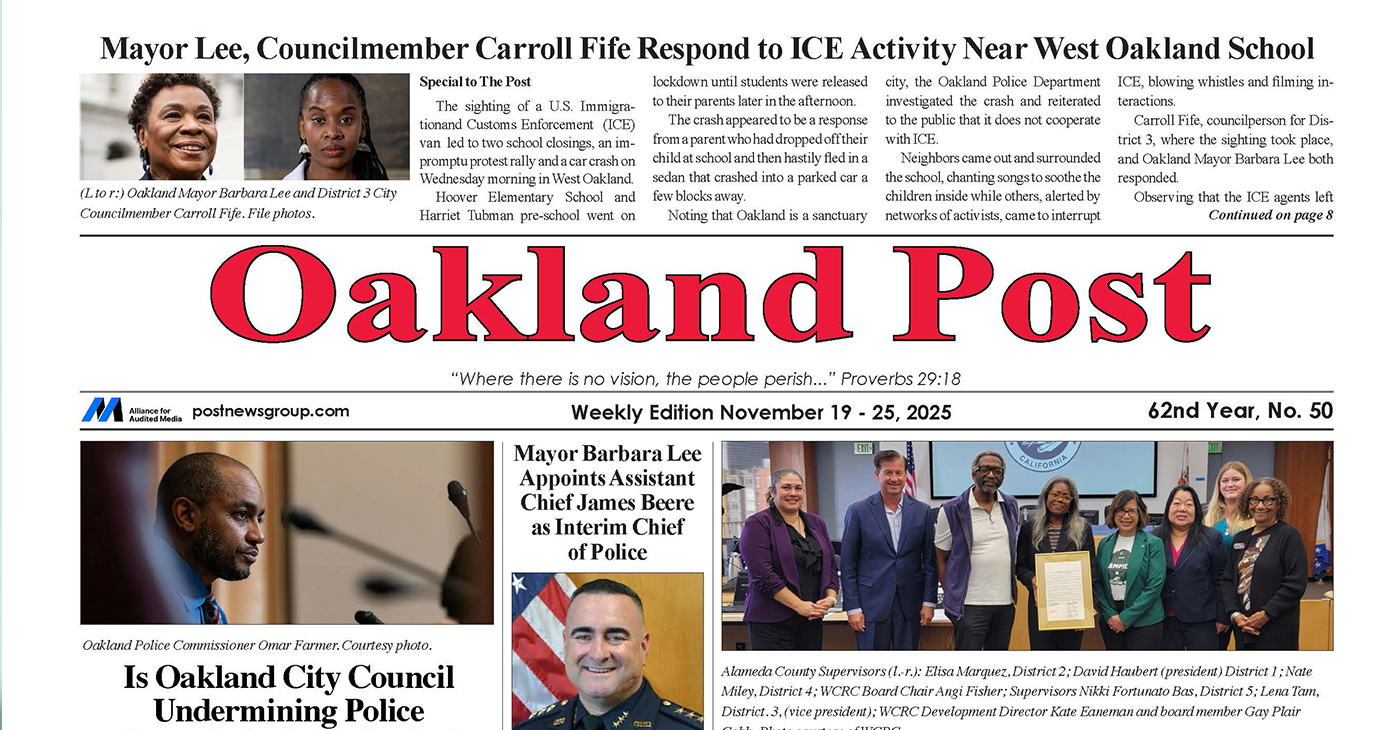Bay Area
Electric Bikeshare and Carshare Debut in the San Joaquin Region
The University of the Pacific hosted San Joaquin Council of Governments and its partners as they launched the Stockton Mobility Collective at a Rise ‘N’ Ride event Saturday. Stockton Mobility Collective project brings clean, affordable transportation to serve economically disadvantaged communities through its nonprofit electric bikeshare and carshare programs.

By Harika Maddala
Bay City News
The University of the Pacific hosted San Joaquin Council of Governments and its partners as they launched the Stockton Mobility Collective at a Rise ‘N’ Ride event Saturday.
Stockton Mobility Collective project brings clean, affordable transportation to serve economically disadvantaged communities through its nonprofit electric bikeshare and carshare programs. The project also includes mobility incentives and a workforce development program – to train Stockton residents in marketable fleet management and operational skills.
Part of the Rise ‘N’ Ride event, the program’s electric cars and bikes were showcased to the community with a chance to test-ride the bikes. The program, funded by a $7.4 million California Air Resources Board Sustainable Transportation Equity Project grant.
The carshare program is managed by nonprofit electric vehicle carsharing service ‘Miocar’. “We are currently working on bringing 30 vehicles for the whole program, and they will be available in different locations across Stockton,” said Christine Tran, assistant regional planner at SJCOG.
Tran said, as of April 1, there are two sites available to pick up cars in Stockton – one at Conway Homes in South Stockton and another on Grand Canal Boulevard near Chic-Fil-A on West March Lane.
Users can access the cars through the Miocar Networks application of App Store and Google Play Store. The account requires driver’s license and a payment method, with an initial charge of $20 which will be credited back to account to use after booking a vehicle.
The bikeshare program called ‘Bike Stockton’ is managed by the San Joaquin Regional Transit District. “Right now, we’re at phase one launch, and we have five stations across Stockton, with 40 bikes out,” said Nathan Schultz, director of operations at Bike Stockton.
Schultz said Bike Stockton aims to have 10 to 12 bike stations with 105 bikes in 2023.
The bikes are available to rent through the ‘Bike Share’ application on App Store and Google Play Store. A bike can be unlocked with a payment of $1, and the rider will be charged $0.15 per minute. The app also offers an annual pass for $40, with riders getting 30 minutes of free ride time per day and will be charged $0.05 per minutes after the free 30 minutes ride time.
Jessica Bilecki, sustainability director at UoP, said the university is hosting one of the e-bike stations by the library patio off of David Brubeck Way.
“It’s a huge benefit for students,” Bilecki said “It gives them more affordable options for getting to and off campus to access resources.”
Many students took the opportunity to ride the bikes, taking turns getting back on them for a second ride across the campus. “It’s very fast, you barely hit the pedal and you just go,” Olivia Mitchell said of her first time experiencing riding an e-bike.
The bikes ride at a maximum speed of 16 mph.
“Those things are very fast here. Yeah, I didn’t expect them to be that fast,” said Shawn Chatrath, digital media manager for Downtown Stockton. “But that’s good. You know, you can get around really, really quickly around this whole city.”
Copyright © 2023 Bay City News, Inc. All rights reserved. Republication, rebroadcast or redistribution without the express written consent of Bay City News, Inc. is prohibited. Bay City News is a 24/7 news service covering the greater Bay Area.
Alameda County
Seth Curry Makes Impressive Debut with the Golden State Warriors
Seth looked comfortable in his new uniform, seamlessly fitting into the Warriors’ offensive and defensive system. He finished the night with an impressive 14 points, becoming one of the team’s top scorers for the game. Seth’s points came in a variety of ways – floaters, spot-up three-pointers, mid-range jumpers, and a handful of aggressive drives that kept the Oklahoma City Thunder defense on its heels.

By Y’Anad Burrell
Tuesday night was anything but ordinary for fans in San Francisco as Seth Curry made his highly anticipated debut as a new member of the Golden State Warriors. Seth didn’t disappoint, delivering a performance that not only showcased his scoring ability but also demonstrated his added value to the team.
At 35, the 12-year NBA veteran on Monday signed a contract to play with the Warriors for the rest of the season.
Seth looked comfortable in his new uniform, seamlessly fitting into the Warriors’ offensive and defensive system. He finished the night with an impressive 14 points, becoming one of the team’s top scorers for the game. Seth’s points came in a variety of ways – floaters, spot-up three-pointers, mid-range jumpers, and a handful of aggressive drives that kept the Oklahoma City Thunder defense on its heels.
One of the most memorable moments of the evening came before Seth even scored his first points. As he checked into the game, the Chase Center erupted into applause, with fans rising to their feet to give the newest Warrior a standing ovation.
The crowd’s reaction was a testament not only to Seth’s reputation as a sharpshooter but also to the excitement he brings to the Warriors. It was clear that fans quickly embraced Seth as one of their own, eager to see what he could bring to the team’s championship aspirations.
Warriors’ superstar Steph Curry – Seth’s brother – did not play due to an injury. One could only imagine what it would be like if the Curry brothers were on the court together. Magic in the making.
Seth’s debut proved to be a turning point for the Warriors. Not only did he contribute on the scoreboard, but he also brought a sense of confidence and composure to the floor.
While their loss last night, OKC 124 – GSW 112, Seth’s impact was a game-changer and there’s more yet to come. Beyond statistics, it was clear that Seth’s presence elevated the team’s performance, giving the Warriors a new force as they look to make a deep playoff run.
Activism
Oakland Post: Week of November 26 – December 2, 2025
The printed Weekly Edition of the Oakland Post: Week of November 26 – December 2, 2025

To enlarge your view of this issue, use the slider, magnifying glass icon or full page icon in the lower right corner of the browser window.
Activism
Oakland Post: Week of November 19 – 25, 2025
The printed Weekly Edition of the Oakland Post: Week of November 19 – 25, 2025

To enlarge your view of this issue, use the slider, magnifying glass icon or full page icon in the lower right corner of the browser window.
-

 Activism3 weeks ago
Activism3 weeks agoOakland Post: Week of November 12 – 18, 2025
-

 Activism4 weeks ago
Activism4 weeks agoOakland Post: Week of November 5 – 11, 2025
-

 Activism2 weeks ago
Activism2 weeks agoIN MEMORIAM: William ‘Bill’ Patterson, 94
-

 Activism3 weeks ago
Activism3 weeks agoHow Charles R. Drew University Navigated More Than $20 Million in Fed Cuts – Still Prioritizing Students and Community Health
-

 Bay Area3 weeks ago
Bay Area3 weeks agoNo Justice in the Justice System
-

 #NNPA BlackPress3 weeks ago
#NNPA BlackPress3 weeks agoThe Perfumed Hand of Hypocrisy: Trump Hosted Former Terror Suspect While America Condemns a Muslim Mayor
-

 #NNPA BlackPress2 weeks ago
#NNPA BlackPress2 weeks agoTrump’s Death Threat Rhetoric Sends Nation into Crisis
-

 #NNPA BlackPress4 weeks ago
#NNPA BlackPress4 weeks agoProtecting Pedophiles: The GOP’s Warped Crusade Against Its Own Lies



















































